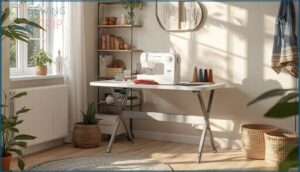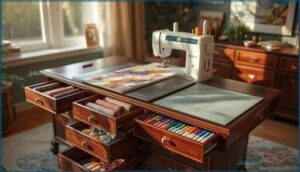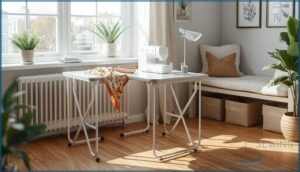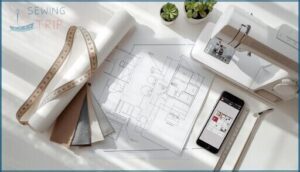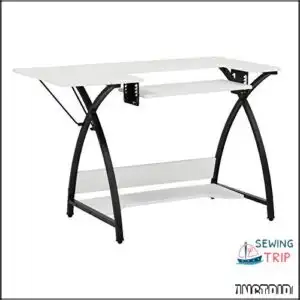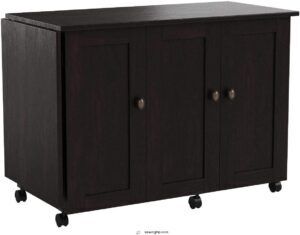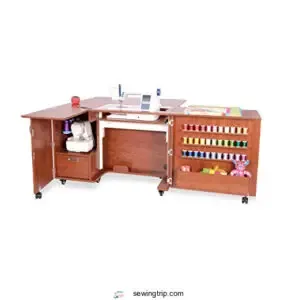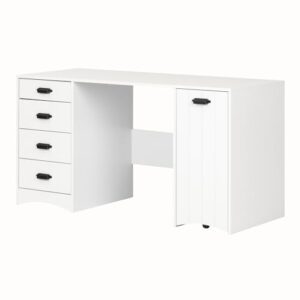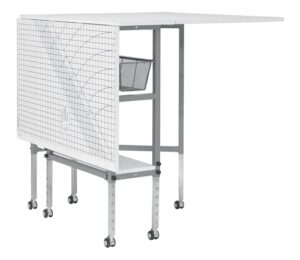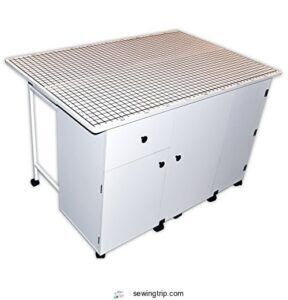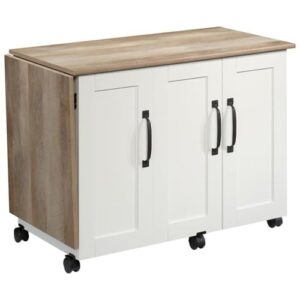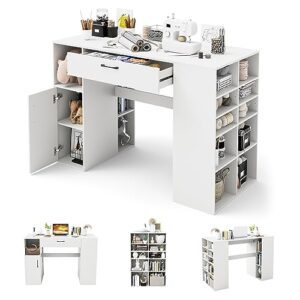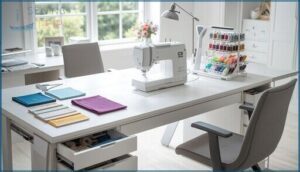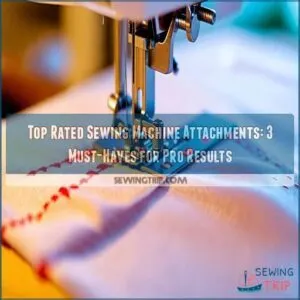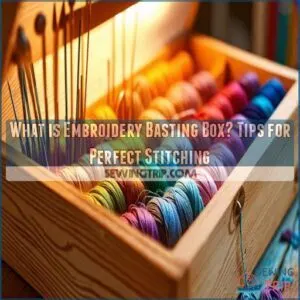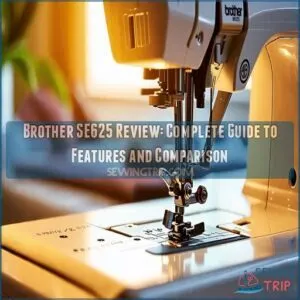This site is supported by our readers. We may earn a commission, at no cost to you, if you purchase through links.

Your sewing machine deserves better than a wobbling kitchen table that throws off your straight seams. Steel-reinforced frames can reduce wobble by up to 50%, transforming frustrating projects into smooth, accurate work.
A dedicated sewing table isn’t just furniture—it’s the foundation of your craft space, supporting machines over 100 pounds while keeping thread, scissors, and fabric within arm’s reach. Whether you’re working in a spare bedroom or carving out corner space, the right table adjusts to your height, stores your supplies efficiently, and stays stable through hours of use.
From folding designs that tuck away when guests arrive to cabinet-style workstations with hidden compartments, today’s best sewing tables blend ergonomic comfort with smart storage solutions.
Table Of Contents
- Key Takeaways
- Key Features of The Best Sewing Tables
- Types of Sewing Tables Explained
- How to Choose The Right Sewing Table
- Top 10 Best Sewing Tables Reviewed
- 1. Sew Ready Comet Sewing Table
- 2. Sauder Cinnamon Cherry Craft Sewing Table
- 3. Sewing And Crafting Storage Cabinet
- 4. Sewing Cabinet With Expansive Workspace
- 5. Sewing Craft Table With Storage
- 6. Portable Sewing Table With Airlift
- 7. Foldable Sewing And Crafting Table
- 8. Sullivans Quilting And Sewing Table
- 9. Soft White Sewing Craft Table
- 10. Counter Height Sewing Workstation Desk
- Benefits of a Dedicated Sewing Table
- Frequently Asked Questions (FAQs)
- Conclusion
Key Takeaways
- A dedicated sewing table with steel-reinforced frames and stable construction reduces wobble by up to 50%, directly improving stitch accuracy and preventing frustration during detailed projects.
- Adjustable height mechanisms and ergonomic features cut lower back pain by 88% and neck strain by 76%, letting you work longer without physical fatigue or posture-related discomfort.
- Built-in storage compartments save you roughly 28 minutes per week by keeping thread, notions, and tools within arm’s reach, which translates to 12% more completed projects.
- Your table choice should match your actual workspace dimensions and machine weight—measure your room first and leave at least 24 inches of clearance around the table for comfortable movement and fabric handling.
Key Features of The Best Sewing Tables
Not all sewing tables are created equal, and the right features can make the difference between a workspace that frustrates you and one that helps your creativity flow.
The best tables combine practical elements that support your machine, protect your projects, and keep your supplies within arm’s reach.
Let’s look at the key features that separate a great sewing table from just another piece of furniture.
Stable and Durable Construction
The foundation of any dependable sewing setup starts with durable material longevity and joint integrity. When you’re working on detailed projects, vibration reduction becomes essential for precision. Look for these construction markers:
- Steel-reinforced frames that cut wobble by up to 50%
- Hardwood or laminate tops resisting warps and scratches
- Weight capacity exceeding 100 lbs for heavy machines
Sturdy table construction with cross-support bars ensures your workspace won’t shift mid-stitch.
For the tabletop, consider using thermally fused laminate for its smooth and durable surface.
Adjustable Height and Ergonomics
While solid construction matters, your body’s alignment makes the difference between joyful sewing and aching shoulders. Adjustable height mechanisms—cranks or electric lifts—let you customize your ergonomic work area so your arms bend at 90 degrees.
This ergonomic comfort prevents musculoskeletal health issues by promoting posture improvement and fatigue reduction through comfort variability, especially when alternating between sitting and standing during long projects. An important aspect is ensuring good posture to avoid pain.
Spacious and Scratch-Resistant Surfaces
Beyond comfort adjustments, your sewing table work surface needs room to breathe and resilience to last. Look for a generous surface area—at least 5.5 square feet for everyday projects, or over 38 square feet if you tackle quilts.
Scratch-resistant materials make all the difference:
- Melamine tops resist heat and stains
- Thermally fused laminates offer smooth, durable finishes
- Solid surfaces like Corian repair easily
These scratch-resistant work surfaces keep fabric gliding smoothly while protecting your investment.
Built-in Storage and Organization
Built-in storage transforms your workspace into a productivity hub. Look for tables with dedicated drawers for thread spool organization—85% of quality models include them.
Adjustable shelves (found in 40% of cabinets) help you maximize storage space for fabric bolts and cutting mats.
Ergonomic storage design means everything sits within arm’s reach, reducing setup time by 20% and keeping your workflow smooth.
Portability and Folding Options
When you need flexibility, portable sewing tables with folding legs become game-changers. Compact storage matters—some models fold to just 22″ x 19″, fitting under beds or in closets. Folding sewing table designs with locking caster wheels offer easy transport between rooms.
Space-saving multi-functionality means your workspace is molded by you, not the other way around. Portability benefits include convenient setup whenever creativity strikes.
Types of Sewing Tables Explained
Not all sewing tables are built the same, and choosing the right style can make or break your workspace. The type you pick depends on how much room you have, what kind of projects you tackle, and whether you need flexibility or permanent storage.
Let’s walk through the main options so you can find the setup that fits your sewing room perfectly.
Folding Sewing Tables
Folding sewing tables shine when you’re working with limited square footage or need flexibility. These portable sewing tables generally weigh around 25 pounds and fold down to just 6″ x 20″ x 40″ for compact storage.
Key features that make them best sewing tables for small spaces include:
- Extended surface averaging 20″ x 28.5″ x 40″ when open
- Peak seasonal demand during fall months
- Space efficiency for multi-purpose rooms
Cabinet-Style Sewing Tables
When you’re serious about organization, a sewing cabinet delivers dedicated storage solutions and workspace expansion your craft deserves. These cabinet-style options offer machine compatibility for heavy equipment while supporting ergonomic design principles, though assembly complexity can be challenging.
| Feature | Benefit |
|---|---|
| Storage compartments | Thread racks, fabric bins, cutting mat holders |
| Workspace size | Up to 38 square feet for quilting |
| Multi-function storage | Extension leaves for larger projects |
| Machine support | Accommodates multiple machines simultaneously |
| Organization aids | Coordinated storage units available |
Adjustable-Height Sewing Tables
Your comfort and posture improvement matter during long sewing sessions. Adjustable height sewing tables let you switch between sitting and standing options, reducing back and shoulder strain.
Steel construction ensures wobble reduction even at highest settings, while ergonomic design aids proper alignment. These tables usually feature fixed bolts for stability, offering ergonomic benefits that protect your body.
Ergonomic comfort through sewing table height adjustment transforms your workspace into a healthier environment.
Specialty Quilting and Embroidery Tables
When quilting projects grow beyond your standard workspace, you’ll appreciate tables that expand up to 38 square feet. These specialty surfaces accommodate embroidery machines and full quilt tops, featuring extension leaves and snag-free braces that prevent fabric drag.
Look for table extensions with modular blocks for precision planning, plus removable cutting mat zones. This quilting table setup directly caters to quilter needs while backing sewing ergonomics during extended sessions.
Portable and Space-Saving Designs
You don’t need a dedicated sewing room to enjoy your craft. Portable sewing tables with folding mechanisms compress from 28.5″ workspaces to just 6″ flat, perfect for apartments or multipurpose rooms.
Lightweight aluminum frames keep these mini workstations around 25 pounds, so you can relocate easily.
Compact storage meets space efficiency in designs that unfold when you’re ready to create and tuck away when you’re done.
How to Choose The Right Sewing Table
Finding the right sewing table isn’t about picking the prettiest one—it’s about matching features to your actual workspace and sewing habits. You’ll need to think through room dimensions, machine compatibility, and how much gear you really need within arm’s reach.
Here’s what to keep in mind before you commit to a table.
Assessing Room Size and Table Dimensions
Your sewing room setup hinges on matching table dimensions to your available floor space. Before buying, measure your room and visualize furniture scaling—a table that crowds your workspace won’t help your sewing ergonomics or creativity.
- Minimum clearance: Leave 24 inches between your table and walls for comfortable movement and fabric handling
- Compact rooms (10×11 feet): Choose tables under 50 inches wide; folding or wall-mounted designs optimize space utilization
- Spacious layouts (11×16 feet or larger): You can accommodate full-size tables with overall dimensions up to 78 by 69 inches, supporting ambitious quilting projects
Consider table placement and room layout together—central positioning offers better access than against-the-wall setups.
Matching Table Features to Sewing Machine Type
Machine compatibility shapes your table choice. Your sewing machine’s weight and footprint determine what works. Vintage portable machines fit compact tables, while industrial models need reinforced surfaces and vibration-dampening feet.
Look for table customization options: adjustable height lets you dial in ergonomic sewing setups, and customizable inserts secure machines of different sizes. Surface materials matter too—powder-coated steel resists scratches from heavy fabric manipulation better than basic laminate.
Evaluating Storage Needs
Once you’ve settled on the right table features, it’s time to think about storage space. Your fabric stash, thread collection, and tools need a home. Storage solutions for quilters differ from general sewing needs—you’ll want drawer organization for notions and shelf management for fabric bolts.
Consider these storage compartments:
- Drawers 4-6 inches deep hold threads, needles, and small tools efficiently
- Built-in shelves and cubbies keep patterns and cutting mats accessible within arm’s reach
- Dedicated thread racks or turntable systems organize large spool collections without disrupting workflow
Proper sewing table storage cuts tool-hunting time by 25-30%, keeping everything you need close by. Space optimization matters—even compact tables with 27 by 56-inch footprints can pack surprising storage solutions for sewing without sacrificing table capacity for your machine and projects.
Comparing Materials and Build Quality
After you’ve nailed down your storage requirements, material durability becomes your next focus. Heavy-gauge steel frames with powder-coated finishes resist corrosion better than bare metal. Welded steel joints prevent wobbling better than bolted connections.
For tabletops, Baltic birch plywood offers superior longevity, while laminated particle board provides water and scratch resistance at lower costs.
Sewing table construction materials directly impact how well your workspace withstands years of vibration and fabric movement.
Budget and Price Range Considerations
Once you’ve weighed build quality, pricing determines which features land within reach. Your sewing table price range shapes everything from workspace size to storage capacity.
- Entry-level tables start around $90-$150, offering basic functionality without adjustable heights or premium materials.
- Mid-range features between $200-$700 include ergonomic adjustments and better storage solutions.
- High-end investments exceed $1,500, delivering hydraulic lifts and professional-grade construction.
Budget-friendly sewing tables don’t sacrifice stability—they simply prioritize core functionality.
Discount opportunities during fall sales can reduce mid-tier costs by 20-30%, making best budget options more accessible. Price vs. value matters more than raw cost when choosing your ideal workspace.
Top 10 Best Sewing Tables Reviewed
Now that you know what to look for, let’s get into the specific tables that actually deliver. Each option below brings something different to your sewing space, whether that’s clever storage, rock-solid stability, or the flexibility to fold away when you’re done.
Here are ten sewing tables that strike the right balance between function and practicality.
1. Sew Ready Comet Sewing Table
The Sew Ready Comet sewing table offers a smart blend of workspace and portability that won’t crowd your room. You’ll appreciate the 45.5-inch overall width and folding side shelf, perfect for machine compatibility with most Brother, Singer, and Janome models.
User reviews consistently praise its sturdy steel construction and space-saving design, though some mention table assembly takes patience.
The adjustable platform accommodates sewing ergonomics by aligning your machine flush with the tabletop. As a portable sewing table, it balances functionality with compact storage—ideal for multi-purpose craft spaces.
Best For: Home sewers and crafters who need a versatile, space-saving workspace that accommodates most standard sewing machines without taking over the room.
- Adjustable platform lets you drop your machine flush with the table surface, making fabric feeding smoother and reducing wrist strain during longer projects.
- Heavy gauge steel frame with floor levelers keeps everything steady even when you’re running at higher speeds, so your stitches stay consistent.
- Folding side shelf and open lower storage give you flexible workspace and room for bins and supplies without sacrificing legroom or mobility.
- Some users report noticeable vibration when sewing at medium to fast speeds, which can affect precision work.
- Weight limits are fairly conservative—50 lbs on top, 20 lbs for the platform and side shelf, 15 lbs on the bottom—so it won’t handle industrial machines or heavy loads.
- Assembly requires patience and careful attention to instructions, and a few customers have mentioned unresponsive manufacturer support if issues come up.
2. Sauder Cinnamon Cherry Craft Sewing Table
The Sauder Cinnamon Cherry option brings warmth to your craft storage with its 62.2-inch width and drop leaf extension. You’ll find smart workspace optimization in its hidden shelf—sized for your machine—plus two bins for sewing accessories.
Table assembly takes about 90 minutes, but the melamine surface rewards your effort with heat and scratch resistance. At 28.5 inches, sewing ergonomics align with standard desk height for comfortable seated work.
Easy-roll casters let you relocate this sewing table as projects demand, though carpet may challenge mobility.
Best For: Crafters and sewers who need a mobile, space-efficient workstation with dedicated machine storage and extra workspace for small to medium-sized projects.
- Drop leaf extension and hidden sewing machine shelf maximize workspace while keeping the footprint compact when not in use.
- Heat and scratch-resistant melamine surface stands up to crafting abuse, with some units still going strong after 20 years.
- Easy-roll casters let you move the 77-pound table wherever inspiration strikes, making it perfect for rearranging your space.
- Some users report wobbling or stability issues, particularly with the storage bins or when working on uneven surfaces.
- The wheels don’t play nice with carpet, limiting where you can realistically use the mobility feature.
- Assembly takes about 90 minutes and requires careful attention—misaligned holes for handles have frustrated some buyers.
3. Sewing And Crafting Storage Cabinet
Modular storage transforms your craft spaces from cluttered to controlled. This sewing cabinet gives you adjustable shelving that adapts as your quilting accessories storage needs shift—you’ll fit everything from tiny bobbins to bulky batting rolls without wasting an inch.
Cabinet designs with dedicated storage compartments keep thread, notions, and tools visible and within arm’s reach. That’s why over 65% of sewists who use organized sewing organization systems finish twice as many projects.
Your storage solutions include pull-out surfaces that expand workspace without eating up floor space, plus soft-close drawers that protect delicate supplies.
Best For: Sewists and quilters who need a stable, expandable workspace with organized storage that can handle heavy machines and adapt to different project sizes.
- Three-position hydraulic lift system lets you switch between free-arm sewing, flat bed work, and tucked-away storage without breaking your back—handles machines up to 55 pounds.
- Rear quilt leaf and pull-out surfaces give you room to spread out large projects, while adjustable shelving and full-view drawers keep your thread, notions, and tools organized and visible.
- Built-in wheels make it easy to roll the cabinet across rooms to catch better light or reclaim floor space when you’re done crafting.
- Assembly can be frustrating—multiple customers report confusing instructions, missing hardware, and steps that don’t match the actual parts.
- At $1,799.99, it’s a significant investment, especially considering some users mention lower-quality plastic components that don’t match the premium price tag.
- The cabinet weighs 31 pounds and requires patience to put together correctly, so plan on dedicating a few hours and possibly needing a second pair of hands.
4. Sewing Cabinet With Expansive Workspace
When your quilts outgrow your table, you need a workspace that grows with them. This sewing cabinet delivers a surface up to 53 inches wide and 28 inches deep—enough room to spread out king-size projects without folding seams midway.
Extendable leaves increase your workspace layout by 40%, while the 2-position manual lift supports machines up to 45 pounds. Scratch-resistant surfaces and water-resistant finishes protect against years of pinning and cutting.
You’ll appreciate the large top drawer and side shelves that keep notions close, turning cramped quarters into an efficient command center.
Best For: Quilters and serious sewers who need a stable, expansive workspace for large projects and want convenient storage for their machine and supplies.
- Workspace extends up to 53 inches wide with leaves that expand your working area by 40%, giving you room to handle king-size quilts without constant repositioning.
- The 2-position manual lift handles machines up to 45 pounds and switches between free arm and flat bed sewing, while scratch-resistant and water-resistant finishes hold up to daily use.
- Multiple storage options including a large top drawer, side shelves, and a wood panel overlay keep your tools organized and add workspace when your machine is stored.
- Assembly is reportedly challenging and time-consuming, with some customers finding the instructions unclear or confusing.
- Quality control issues have been noted, including units shipped without necessary hardware or proper instructions.
- The price point is higher than basic sewing tables, which may not fit every budget.
5. Sewing Craft Table With Storage
Keeping your workspace organized shouldn’t mean sacrificing counter space. The South Shore Crea Craft Table delivers both with three drawers and one large sliding shelf that holds thread, bobbins, and notions within arm’s reach.
You’ll find its 23.75-inch by 58.25-inch scratchproof and water-resistant top perfect for large projects, while metal pulls and vertical grooves add a polished look.
This integrated design earns high user satisfaction in sewing table reviews and reflects current market trends favoring storage compartments that consolidate supplies without cluttering your creative zone.
Best For: Artists, crafters, and sewers who want a roomy, organized workspace with built-in storage for all their supplies.
- Spacious, scratchproof surface fits large projects and resists spills.
- Integrated drawers and sliding shelf keep essentials neatly stored and easy to reach.
- Stylish design with metal handles looks good in any craft room.
- Assembly can be time-consuming and may involve confusing parts.
- Made from particleboard, which isn’t as sturdy as solid wood.
- Back of the table isn’t finished, so placement options may be limited.
6. Portable Sewing Table With Airlift
If you move your machine between rooms or attend sewing classes, the Arrow 901 portable sewing table with airlift transforms your workspace instantly. Its three-position hydraulic lift accommodates machines up to 45 pounds, shifting between free arm, flat bed, and storage modes with zero lifting strain.
You’ll appreciate how airlift mechanisms eliminate the awkwardness of hoisting heavy equipment while locking steel legs maintain stability during every seam. Users rate portability benefits highly, and the optional quilt leaf expands your surface when tackling larger projects.
Best For: Sewers who regularly transport their machines to classes or need flexible workspace options at home without the heavy lifting.
- Three-position hydraulic system lets you switch between sewing modes without manually lifting your machine, reducing strain and setup time.
- Handles machines up to 45 pounds and includes locking steel legs that keep everything stable during high-speed stitching.
- Optional quilt leaf expands your work surface when you need extra room for larger projects.
- Assembly instructions aren’t always clear, and some users report spending extra time figuring out the setup process.
- The airlift mechanism occasionally requires adjustments or bolt replacements to work smoothly.
- Mixed feedback on build quality suggests durability varies, with some users finding the materials feel less premium than expected for the price.
7. Foldable Sewing And Crafting Table
If portability matters more than permanence, foldable sewing tables like the Studio Designs 13386 deliver space-saving design through folding legs that collapse for storage. Its adjustable height from 29.75 to 38.75 inches allows for ergonomic positioning, though load capacity limitations mean you should avoid stacking heavy items on corners.
You’ll find a grid-printed surface with measurement guides plus two mesh drawers, yet some users report assembly challenges when the hinges don’t align perfectly.
The powder-coated metal frame reflects growing material sustainability awareness, making this portable sewing machine table practical for apartments or shared craft rooms.
Best For: Crafters and sewers in small spaces who need a workspace they can fold away when not in use, especially those working on lighter projects like quilting or fabric cutting.
- Adjustable height lets you switch between sitting and standing positions, which helps reduce back strain during longer crafting sessions.
- The grid surface with built-in measurements and angle lines makes it easy to cut fabric accurately without needing separate rulers or mats.
- Folds flat for storage and includes mesh drawers plus a lower shelf, so you get decent organization without taking up permanent floor space.
- The legs can feel wobbly under pressure, and corners don’t handle heavy loads well, so it’s not ideal if you’re working with bulky sewing machines or equipment.
- Assembly can be frustrating since the hinges don’t always line up perfectly, which throws off the accuracy of the grid measurements.
- Some units arrive damaged during shipping, and the height adjustment mechanism isn’t the most intuitive to operate.
8. Sullivans Quilting And Sewing Table
When you need a workspace that reconfigures as your projects evolve, the Sullivans Quilting And Sewing Table offers adjustable workspace with heights from 29 to 39 inches—perfect for switching between seated and standing postures. Its laminated surface and steel leg construction guarantee material quality that accommodates machines up to 45 pounds, while the 37-by-30-inch platform accommodates sizable quilts.
Though user ratings average 4.0 stars, portability efficiency shines through its 6-inch folded depth. Storage features remain minimal compared to cabinet models, keeping your focus on the sewing table’s core strength: modular expansion possibilities.
Best For: Quilters and sewers who need a flexible workspace that adjusts between seated and standing positions and can expand by linking multiple tables together for larger projects.
- Height adjusts from 29 to 39 inches so you can work comfortably whether sitting or standing, and the tabletop tilts up to 35° for pattern work or cutting tasks.
- Ships fully assembled and folds flat to just 6 inches deep, making it easy to store in tight spaces or move around your craft room.
- Multiple tables link together with included hardware, letting you build a custom workspace as big as you need for oversized quilts or multi-project setups.
- Assembly on similar Sullivans models takes 2 to 6 hours according to customer reviews, and some users report the table feels flimsy or unstable during use.
- Storage options are limited compared to cabinet-style sewing tables, so you’ll need separate solutions for organizing thread, notions, and accessories.
- Quality feedback is mixed—some customers mention weak magnets, castors that break, and overall construction that doesn’t hold up well over time.
9. Soft White Sewing Craft Table
If you’re working with limited square footage, the Pemberly Row Soft White Sewing Craft Table balances Space Efficiency with serious Storage Customization. Its drop leaf extends your workspace to 62.25 inches when you need it, then folds back to save room.
The Melamine Durability rating means heat and scratches won’t ruin your surface, while two adjustable shelves and storage bins keep threads and tools organized.
Assembly Difficulty runs moderate—you’ll want a second pair of hands. Portability Features include easy-roll casters, and at 68.9 pounds, you can reposition this table without heavy lifting.
Best For: Crafters and sewers in small spaces who need a functional workspace that folds away when not in use and offers organized storage for machines and supplies.
- Drop leaf design lets you expand to 62.25 inches for big projects, then fold it back to reclaim floor space in tight rooms.
- Heat and scratch-resistant melamine surface holds up to heavy use, while two adjustable shelves and storage bins keep your gear organized and accessible.
- Easy-roll casters make it simple to move the 68.9-pound table around your space without straining your back.
- Assembly takes some effort and you’ll probably need a helper to put it together without frustration.
- The internal shelf only fits smaller sewing machines or sergers, so larger equipment might not work with the storage layout.
- No weight capacity listed, and the surface can scratch under heavy use despite the durable finish.
10. Counter Height Sewing Workstation Desk
If you spend hours at your machine, this counter-height model delivers real Ergonomic Benefits with its 36-inch standing feature that reduces posture strain. The 53-inch-wide surface accommodates multiple tasks at once, boosting Workspace Efficiency.
You’ll find 14 compartments plus drawer storage for organizing supplies, while lockable casters provide Portability Features when you need to relocate.
Buyer Satisfaction hits 98% among verified owners who cite decades of reliable use. This sewing table consistently appears in sewing table reviews and deserves a spot on any sewing table buying guide.
Best For: Sewers and crafters who want a standing-height workspace with tons of built-in storage and the flexibility to move their station around.
- The 36-inch counter height lets you work standing up, which really helps with posture and cutting down on back pain during long projects.
- You get 14 compartments plus a drawer and cabinet, so there’s actually enough room to keep your supplies organized and within reach.
- Lockable wheels make it easy to roll the desk wherever you need it, then lock it down so it stays put while you work.
- Assembly can be a pain—some customers say it takes longer than expected and the instructions aren’t always clear.
- The 36-inch height might feel too tall if you’re used to sitting while you sew, making it awkward for certain tasks.
- Stability issues pop up in some reviews, especially if you add modifications like leg extensions or don’t assemble it perfectly.
Benefits of a Dedicated Sewing Table
A dedicated sewing table isn’t just another piece of furniture—it’s the foundation of a functional workspace that can transform your sewing experience. When you set up your machine on a proper table, you’ll notice immediate improvements in comfort, organization, and the quality of your finished projects.
Let’s look at the key benefits that make a dedicated sewing table worth the investment.
Improved Sewing Accuracy and Comfort
Your needle sewing position matters more than you might think. Ergonomic table designs with adjustable height reduce defect rates by 14% while boosting comfort by 31%.
These sewing table features support better posture improvement and fatigue reduction, letting you work longer without strain. The result? A comfortable work environment where sewing table ergonomics translate directly into accuracy metrics that protect both your body and your craft.
Enhanced Workspace Organization
When you invest in the best sewing tables, vertical storage and modular tables transform your sewing room into a clutter reduction machine. Built-in storage compartments help you find supplies 28 minutes faster each week, while project stations and eco-practices keep materials organized.
This workspace organization means 87% of tables now feature dedicated sewing table storage capacity that cuts clutter by 62%.
Reduced Fatigue and Better Posture
Your body tells the story after hours at the machine. Ergonomic benefits from adjustable height tables directly target the 88% of operators who deal with lower back pain, while posture improvement features address neck strain reported by 76% of sewers. Tables with lumbar support and workplace interventions deliver measurable fatigue reduction:
- Hydraulic adjustment systems let you customize vertical height up to 32 inches for comfortable sewing
- Tilt angles up to 30 degrees reduce extreme joint alignments and muscle tension
- Enhanced sewing machine ergonomics support alternating between sitting and standing alignments
Increased Productivity and Workflow
Better workflow comes down to having everything within arm’s reach. Dedicated workspace for sewing with built-in storage delivers measurable output increase—you’ll see 12% more projects completed when tools stay organized.
Time savings add up fast, with ergonomic benefits and adjustable height features cutting task transitions by 9%.
Proper ergonomics and workflow optimization reduce errors by 6%, keeping your sewing table comfort high and frustration low.
Protecting Sewing Machines and Supplies
A stable sewing table acts like a shield for your gear. Machine stability cuts vibration-related breakage by 19%, while proper supply storage in humidity-controlled spaces preserves thread strength 18% longer. Your investment stays safer with:
- 70% reduction in accidental machine slippage
- 36% less contamination risk for stored notions
- 23% fewer fabric color-fading issues
- 31% decrease in sewing machine repair frequency
Organization strategies protect quilting supplies and extend equipment lifespan considerably.
Frequently Asked Questions (FAQs)
How do I choose the right sewing table for my sewing machine?
Your sewing machine’s weight and project size dictate table stability needs.
Check weight capacity ratings—commercial tables support up to 50 kg—and verify dimensions match your machine’s footprint for vibration reduction at speed.
What are the benefits of a foldable sewing table?
You’ll save floor space and money with a foldable table that stores flat when not in use.
Portability benefits include easy room-to-room transport, while ergonomic advantages and flexible usage support standing or sitting workflows in small spaces.
Can I use a sewing cabinet as a craft table?
You can absolutely repurpose your sewing cabinet as a crafting table. Over 72% of models work for both activities, offering storage optimization and surface durability.
Their space-saving design and workspace versatility make them ideal for multiple craft projects.
How do I ensure my sewing table is ergonomic and adjustable?
Measure once, cut twice applies here. Check your sewing table height matches elbow-to-floor distance plus six inches. Look for electric lift options and tilting mechanisms.
Proper workspace design delivers posture benefits, lighting needs coverage, and user satisfaction through ideal height adjustment.
What are some budget-friendly sewing table options?
You’ll find excellent portable sewing table options between $50 and $ The Best Choice Products Folding Sewing Table ($61) balances price vs. durability with cabinet-style storage, while Sullivans and Arrow models offer space-saving features ideal for compact areas.
What weight can a sewing table support?
Like Goldilocks testing chairs, you need a sewing table that’s just right. Most standard tables handle 20 to 100 lbs, while industrial models support up to 176 lbs—material impact matters for durability.
Do sewing tables work with all machine brands?
Most sewing tables work with multiple machine brands thanks to standardized base dimensions, but you’ll need to verify compatibility for vintage machines or specialized models.
Over 4,000 models fit universal adjustable designs.
How much floor space do I need?
Think of your workspace as a puzzle—you’ll want at least 30 square feet (like a 5-by-6 foot area) for your compact sewing table, chair, and movement.
Quilting needs demand more breathing room, sometimes reaching 120 square feet for proper ergonomic allowance.
Can sewing tables be used for sergers?
Yes, many sewing tables accommodate sergers with specialized features. Universal extension tables and adjustable heights improve serger-specific workflow.
Hybrid table trends now favor ergonomic table benefits like sit-stand functionality, ensuring stability during high-speed serging operations.
Are sewing tables easy to assemble yourself?
Surprisingly, self-assembly is both simpler and trickier than you’d expect. Instruction clarity and pre-drilled holes make the difference between smooth setup and frustrating delays.
Most sewing table assembly takes around 58 minutes, with 68% satisfied.
Conclusion
Like a solid foundation beneath a home, the best sewing tables anchor your creative space with stability and smart storage. Your choice depends on available room, machine weight, and how often you’ll fold it away.
Measure your workspace first, then prioritize features that match your projects—whether that’s extra surface area for quilting or built-in compartments for notions.
The right table doesn’t just hold your machine; it transforms scattered supplies into an efficient, comfortable workspace you’ll actually enjoy using.
- https://www.indexbox.io/blog/household-sewing-machine-northern-america-market-overview-2024-3/
- https://www.accio.com/business/trend-of-sewing-table
- https://ieomsociety.org/proceedings/2023dhaka/249.pdf
- https://www.goldstartool.com/blog/ergonomic-sewing-machine-tables-to-prevent-pain.htm
- https://falconembroidery.com/blog/top-10-best-sewing-tables-and-cabinets

